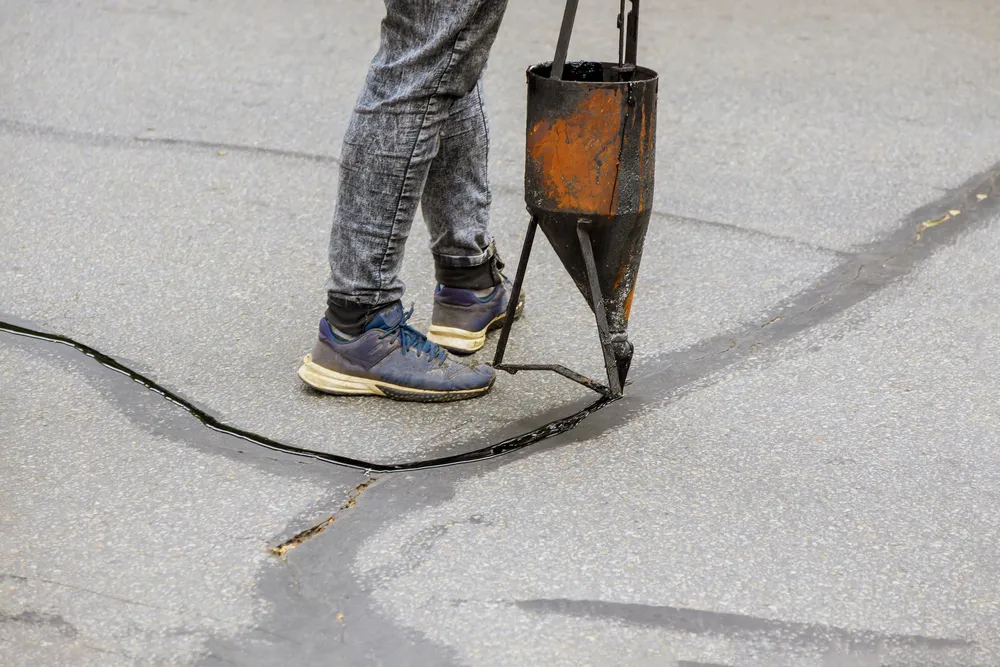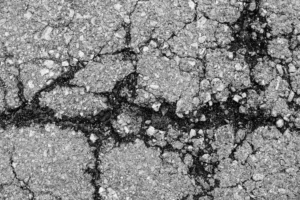Have you noticed cracks forming in your pavement? Don’t ignore them! Cracks can lead to bigger problems like potholes, which can damage vehicles and cause accidents. It’s important to address cracks as soon as possible to prevent further damage and save money in the long run.
One effective way to fix cracks is through crack sealing. This process involves filling the cracks with a specialized material that prevents water from seeping in and causing further damage. In this article, we’ll dive into the process of crack sealing and the benefits it can bring to your pavement.
Why is crack sealing so important?
Crack sealing is an important technique in asphalt pavement maintenance and preservation. It is the process of filling any cracks that have developed in the asphalt surface. This type of repair is essential for the longevity of the pavement, as it helps to prevent further damage from occurring. Crack sealing helps to prevent the growth of cracks, particularly deep and fatigue cracks, from developing further and creating larger cracks in the current condition of the asphalt. It also helps to prevent the intrusion of water and other debris into the asphalt, which can cause further damage and deterioration.
Crack sealing is a great way to preserve and maintain parking lots and other asphalt surfaces. The process helps to prevent the growth of longitudinal cracks and other cracks that can lead to a decrease in the longevity of the pavement or parking lot. It also helps to protect the chip seal that is used in the pavement, which can be damaged and worn out over time without proper maintenance. Crack sealing is a cost-effective solution that helps to maintain the current condition of the asphalt and prevent further damage from occurring.
Benefits of crack sealing
• Prevents further damage from occurring
• Protects chip seal in the pavement
• Prevents the growth of longitudinal cracks
• Prevents the intrusion of water and debris
• Cost-effective solution
• Preserves and maintains parking lots and other asphalt surfaces
• Increases the longevity of the pavement
Best practices for effectively sealing cracks.
Crack sealing is an essential maintenance procedure for any asphalt surface. By properly sealing all cracks, you can protect the pavement from water damage, traffic loads, and other environmental factors.
The best practice for crack sealing is to fill cracks as soon as possible after they appear. This will help prevent them from getting bigger and deeper. Additionally, it’s important to use the right materials for the job.
A rubberized crack sealant is a great option because it not only seals but also adheres to existing pavement surfaces. It’s also flexible enough to move with changes in temperature, which helps prevent the formation of new cracks.
When applying sealant, start at the edges of any active crack and slowly fill it in until you reach the middle of the crack. Make sure to pay attention to alligator cracks (longitudinal and transverse) as well as block cracks (diagonal) since they’re more likely to spread quickly if left untreated. Finally, when you’re finished applying crack sealant, be sure to clean up any excess material that may have spilled onto the pavement or nearby areas.
By following these best practices of crack sealing and using quality materials, you can ensure your asphalt pavement life lasts for years!
Types of cracks in asphalt pavements
Regarding pavement cracks, being knowledgeable about the various types that can appear is crucial. Here are the most common types you’ll come across:
Reflective Cracks – These occur when an existing crack is reflected onto a new layer of asphalt, forming a larger crack. They can range from small to large in size and often require more extensive repairs.
Aligator Cracks – Longitudinal and transverse cracks are known as alligator cracks. These cracks form a pattern that looks like an alligator’s back, hence their name. They’re typically caused by a combination of traffic loads, poor drainage, or weak pavement layers. If left untreated, these types of cracks can quickly spread across a large area.
Non-Working Cracks – Non-working cracks are those that have not moved significantly from their original form and usually appear in cold weather areas. These types of cracks don’t move, but they can widen over time if left untreated.
Block Cracks – Block cracks form in a pattern of four connected cracks that look like a square or rectangle. They’re usually caused by shrinkage or expansion due to temperature changes.
Edge Cracks – Non-working cracks on the edge of an asphalt surface are often caused by pavement movement and increased traffic loading, which can significantly affect the pavement condition. Depending on the severity of the cracks, more extensive repairs may be necessary. These cracks are typically found near curbs and gutters.
What causes asphalt to crack?
Asphalt cracks can be caused by several different factors, but one of the most common causes is elevated temperatures. When the temperature rises, the ground beneath the asphalt expands, leading to stress in the asphalt that can cause both longitudinal and diagonal cracks. Additionally, improper installation, poor drainage, heavy vehicle loads, and wear and tear over time can all contribute to asphalt cracking.
Guidelines for Crack Sealing Maintenance
Crack sealing is an important part of any asphalt maintenance plan. By properly sealing cracks before they have a chance to grow larger, you can protect your pavement from water damage, weeds, and other environmental factors. But knowing when to perform crack sealing is just as important as doing it right!
Generally speaking, experts recommend checking for cracks in your pavement every spring or fall. This way you can identify any new cracks that may have appeared since the last inspection. You should also check for cracks if you notice any changes in the pavement’s appearance or structure, including large potholes, alligator cracking (longitudinal and transverse), block cracking (diagonal), or edge cracking.
If you do find any active cracks in your asphalt surface, it’s best to address them as soon as possible with rubberized crack sealant. This will help keep them from spreading and causing further damage to the pavement. Just make sure to apply the sealant slowly and carefully so that it fills in the entire crack without spilling onto surrounding areas.
Crack Sealing vs Crack Filling? Is it the same?
Crack sealing is a specialized procedure that utilizes specialized material to seal cracks in asphalt or concrete surfaces.
Crack sealant is injected into the crack with a caulking gun, leaving the material to settle into the crack, and then smooth out excess material until it’s flush with the pavement. Crack sealing needs more care and attention during installation than crack filling because of the complexities of working with hot-applied materials.
However, when done properly, it can provide a lasting solution that bridges gaps and prevents water from seeping into underlying layers of the soil underneath the pavement.
Crack filling is another procedure best suited for asphalt pavements. Crack filling involves applying pre-mixed (manufactured) cold pourable crack filler onto existing cracks on the pavement surface which forms an impermeable seal against water infiltration.
Unlike crack sealing, this method does not involve heating anything up, but still requires careful placement of the material so as to maximize its effectiveness in bridging gaps between existing pavement components.
With proper maintenance procedures like regular inspection and repair when needed, crack filling can also be cost-effective in preventing further damage to your asphalt pavement caused by moisture infiltration through cracks.
3 essential steps for crack sealing
Crack sealing is essential for maintaining asphalt pavement and preventing further cracking and damage. There are three essential steps to ensure a successful crack sealing job: let’s dive into them.
1. The surface should be made ready.
Preparing the surface for crack sealing is critical to a successful job. If the surface isn’t properly cleaned and prepped, it can lead to material failure and a short service life. The first step is to calculate the crack density of the pavement area. This will help you determine which cracks need to be routed before they are sealed.
Generally speaking, larger cracks (over 1/2 inch wide) should be routed with a saw or router before applying sealant. This creates a clean edge which allows for better adhesion of the sealant material.
Additionally, routing helps create a defined reservoir that holds the appropriate amount of sealant to accommodate anticipated thermal movement.
Finally, be sure to remove any loose debris or vegetation from within the crack prior to filling in order to ensure proper bonding between sealant and pavement surfaces. Proper preparation of the surface is key for successful crack sealing so make sure you take your time and do it right!
2. Prep your materials
When it comes to crack sealing, the preparation of your surface is key. Before you get started, it’s important to calculate the crack density of the pavement area and determine which cracks need to be routed before sealing.
Routing creates a clean edge for better adhesion and provides a defined reservoir for the sealant material. It’s also essential that you remove any loose debris or vegetation from within the crack prior to filling in order to ensure proper bonding between sealant and pavement surfaces. Taking your time with this step can really pay off in terms of a successful result!
3. Application of crack sealants
When it comes to crack sealing, proper application is essential for a successful result. The key to success is making sure the crack sealant is applied in the right way.
First, ensure that the temperature of the pavement and material are within manufacturer specifications to ensure proper adhesion. Then use a wand tip that fits the size of the crack being filled, as well as the type of sealant used.
Finally, apply the crack sealant in an even, continuous stream while keeping pressure on your wand steady.
Be sure to not overfill the crack or leave behind any excess material. With these simple steps, you can help extend the life of your asphalt pavement and protect it from further cracking and damage caused by water intrusion and traffic loads.
Conclusion
Asphalt crack sealing is an important preservation treatment that should be performed regularly in order to preserve the condition of the pavement. It is important to inspect the pavement for any cracks, and if any are found, it is crucial to determine the type of crack and size of the crack.
Wider cracks may require more specialized crack sealant in order to successfully repair them. Taking the time to properly prepare the surface and apply the appropriate crack sealant correctly can help ensure successful preservation treatments and extend the life of your asphalt pavement.



